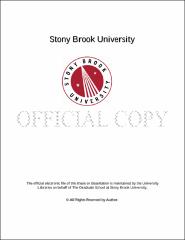| dc.identifier.uri | http://hdl.handle.net/11401/77634 | |
| dc.description.sponsorship | This work is sponsored by the Stony Brook University Graduate School in compliance with the requirements for completion of degree. | en_US |
| dc.format | Monograph | |
| dc.format.medium | Electronic Resource | en_US |
| dc.language.iso | en_US | |
| dc.publisher | The Graduate School, Stony Brook University: Stony Brook, NY. | |
| dc.type | Dissertation | |
| dcterms.abstract | ABSTRACT OF THE DISSERTATION <italics>Francisella tularensis<italics>: Interactions with Hepatocytes and Pathways for the Acquisition of Iron by Cindy A. Thomas-Charles Doctor of Philosophy in Genetics Stony Brook University 2013 <italics>Francisella tularensis<italics> is a Gram-negative, facultative intracellular bacterium and the causative agent of tularemia. Due to its high virulence, this organism has been classified as a Tier 1 select agent of bioterrorism. Regardless of the route of inoculation, the lungs, spleen, and liver are major targets of infection. Furthermore, this organism replicates to high numbers in hepatocytes, the predominant cells in the liver. Factors that mediate the uptake by and replication of <italics>F. tularensis<italics> in hepatocytic cell lines or primary mouse hepatocytes were investigated. <italics>F. tularensis<italics> was observed to be taken up by hepatocytes in a process that required polymerization of the hepatocyte actin cytoskeleton, but not the bacterial type I secretion system or type IV surface pili. Killed bacteria and bacteria rendered incapable of synthesizing protein were still ingested efficiently, suggesting involvement of a pre-formed bacterial surface structure in uptake. <italics>F. tularensis<italics> transposon mutants were subsequently screened for their ability to be taken up by or replicate in hepatocytes. Two mutants with decreased replicative capacity were identified. Additionally, primary mouse hepatocytes were used to determine the response of these host cells to infection with <italics>F. tularensis<italics>. Following infection, hepatocytes increased the expression of several genes encoding cytokines involved in inflammation. Furthermore, two potent chemotactic cytokines, CXCL1 and CXCL5, were secreted in increased amounts by infected hepatocytes. The ability to acquire extracellular iron is a key requirement for the replication of <italics>F. tularensis<italics> in hepatocytes. In some bacterial species, FeoB forms the core of the ferrous iron acquisition system. A mutant strain of <italics>F. tularensis<italics> lacking FeoB was used to investigate this protein's role in growth and virulence. Loss of FeoB diminished the growth of <italics>F. tularensis<italics> in medium with restrictive levels of iron and in hepatocytes and epithelial cells. The FeoB-deficient mutant was still capable of causing lethal disease in mice. However, its ability to colonize the liver, spleen, and lungs of mice was markedly impaired. These studies suggest that the interactions between <italics>F. tularensis<italics> and hepatocytes are important in the pathogenesis of tularemia. | |
| dcterms.available | 2017-09-20T16:53:07Z | |
| dcterms.contributor | Bliska, James | en_US |
| dcterms.contributor | Furie, Martha B | en_US |
| dcterms.contributor | Kew, Richard | en_US |
| dcterms.contributor | Thanassi, David G | en_US |
| dcterms.contributor | Monga, Satdarshan. | en_US |
| dcterms.creator | Thomas-Charles, Cindy Arisa | |
| dcterms.dateAccepted | 2017-09-20T16:53:07Z | |
| dcterms.dateSubmitted | 2017-09-20T16:53:07Z | |
| dcterms.description | Department of Genetics. | en_US |
| dcterms.extent | 154 pg. | en_US |
| dcterms.format | Monograph | |
| dcterms.format | Application/PDF | en_US |
| dcterms.identifier | http://hdl.handle.net/11401/77634 | |
| dcterms.issued | 2013-12-01 | |
| dcterms.language | en_US | |
| dcterms.provenance | Made available in DSpace on 2017-09-20T16:53:07Z (GMT). No. of bitstreams: 1
ThomasCharles_grad.sunysb_0771E_11626.pdf: 2200223 bytes, checksum: a029db03f2fc99bc7464927a50f04a26 (MD5)
Previous issue date: 1 | en |
| dcterms.publisher | The Graduate School, Stony Brook University: Stony Brook, NY. | |
| dcterms.subject | Cytokine, Francisella tularensis, Hepatocytes | |
| dcterms.subject | Biology | |
| dcterms.title | Francisella tularensis: Interactions with Hepatocytes and Pathways for the Acquisition of Iron | |
| dcterms.type | Dissertation | |

